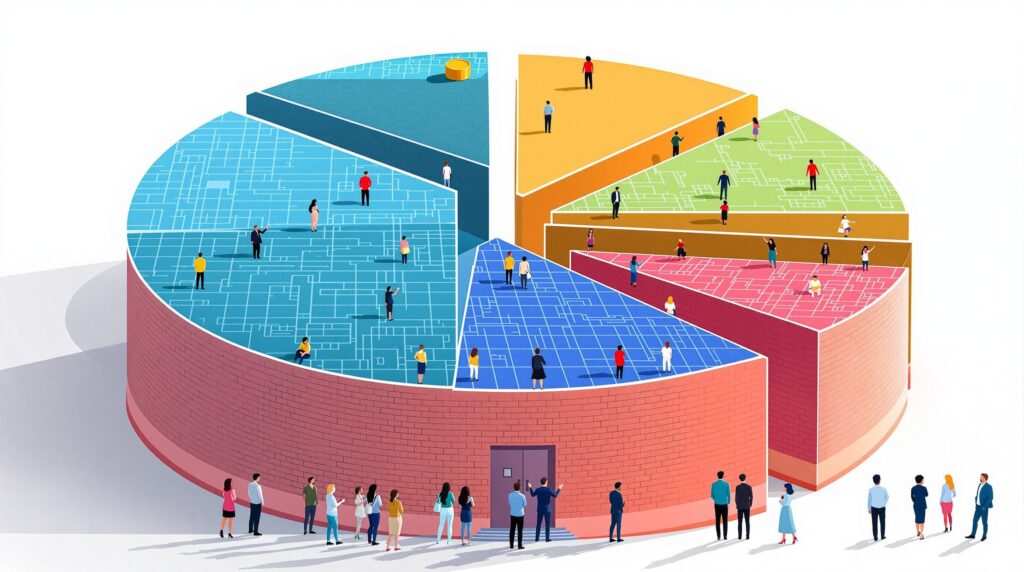[rev_slider alias=”slider-1″][/rev_slider]
Understanding Layer 1 Blockchains
When diving into the world of blockchain technology, you’ll often hear about Layer 1 Blockchains. But what exactly are they? Let’s break it down. At its core, a Layer 1 blockchain refers to the underlying main blockchain architecture, like Bitcoin or Ethereum, providing the foundational network on which other applications and protocols run. Think of it as the highway where all the vehicles—transactions, dApps, and smart contracts—move. Without this layer, the infrastructure of these other technologies wouldn’t exist.
What is a Layer 1 Blockchain? A Layer 1 blockchain is the main blockchain architecture, serving as the foundational network for applications and protocols such as Bitcoin and Ethereum.
Layer 1 solutions are crucial because they set the primary rules for operations within a blockchain, determining how transactions are verified, and how blocks are added to the chain. Essentially, they are responsible for ensuring that the network remains secure and operates smoothly. If you’ve ever wondered why blockchain is often hailed for its security and transparency, thank the Layer 1 solutions that form its backbone.
The Importance of Layer 1 Speed
Now that we have a basic understanding of Layer 1 blockchains, let’s explore why their speed matters. Imagine if your highway had only a single lane, causing traffic jams and frustrating delays. The speed and efficiency of a Layer 1 blockchain determine how quickly transactions can be processed and verified. This efficiency directly impacts the user experience and the scalability of the network.
Faster Layer 1 blockchains can handle more transactions per second (TPS), making them more appealing for large-scale applications and industries looking to leverage blockchain for everything from finance to supply chain management. When speed is optimized, users experience fewer delays and reduced costs, bringing blockchain applications closer to mainstream adoption.
Why does Layer 1 speed matter? Faster Layer 1 blockchains facilitate higher transaction rates, enhance user experience, and encourage broader industry adoption of blockchain technology.
Technical Factors Influencing Speed
Several technical elements dictate why some Layer 1 blockchains outpace others. One primary factor is the consensus mechanism employed. For instance, blockchains using Proof of Stake (PoS) often process transactions faster than those relying on the older Proof of Work (PoW) model. PoS allows for more transactions because it requires less energy and computing power to validate transactions, resulting in faster block times.
Another significant factor is the block size. Larger blocks can contain more transactions, thus accelerating the process; however, they can also lead to increased memory requirements and risk of centralization. It’s a delicate balance between speed and maintaining decentralized control.
The Role of Protocol Upgrades
Blockchain technology is ever-evolving, with developers constantly seeking methods to improve Layer 1 speed. These improvements often come in the form of protocol upgrades, which might introduce more efficient data structures or streamline transaction processes. One example is Ethereum’s upgrade from Ethereum 1.0 to Ethereum 2.0, designed to transition from PoW to PoS and improve scalability significantly. Such updates are crucial as they keep the underlying technology robust and versatile enough to accommodate increasing demands.
So, if you’re investing or developing on a blockchain network, understanding these technical factors and their implications can be incredibly beneficial. They can make all the difference in achieving a seamless and responsive blockchain experience.
Layer 1 vs. Layer 2 Solutions: A Brief Comparison
While Layer 1 is the foundation, Layer 2 solutions build upon this groundwork to enhance speed and efficiency. Think of Layer 2 as an express lane on the highway, designed to alleviate congestion on the main route. Layer 2 aims to process transactions off-chain and then record them in batches back to the primary blockchain, alleviating pressure on the Layer 1 infrastructure.
Incorporating Layer 2 solutions allows for virtually unlimited scaling potential without jeopardizing the core security features of the blockchain. It fosters innovation in the blockchain space, making networks more adaptable and inclusive for diverse applications and user bases. In the context of Africa—a region teeming with potential—expanding capacities through Layer 2 could unlock unprecedented economic opportunities.
How do Layer 1 and Layer 2 blockchains differ? Layer 1 blockchains form the main network infrastructure, while Layer 2 solutions enhance speed and scalability by processing transactions off-chain.
By understanding these distinctions, one can see why innovations at both layers are essential for the blockchain industry’s future growth. To tap into the full potential of blockchain, particularly in vibrant markets like Africa, leveraging both Layer 1 and Layer 2 technologies is essential.
As you delve deeper into the capabilities of `Jara` and its approach towards transforming African digital assets, these insights into Layer 1 blockchains and their speed not only highlight the intricacies of blockchain technology but also underscore the potential impact on the region’s economic landscape.
Understanding Personal Injury Claims in [Location]
When accidents happen, it often leaves victims wondering, “What now?” Navigating the aftermath of a personal injury can be overwhelming, especially when trying to understand if you have a valid claim. Our law firm in [Location] is dedicated to helping you through this challenging time with clarity and support.
What Qualifies as a Personal Injury?
A personal injury occurs when someone is harmed due to another party’s negligence or intentional misconduct. This can be due to a variety of incidents, such as a slip and fall in a grocery store or a car accident on a busy road. Curious about what constitutes negligence? Imagine a situation where a driver is texting instead of focusing on the road. That oversight can lead to accidents and injuries.
Steps to Take After a Personal Injury
- Seek Medical Attention: Prioritize your health by visiting a healthcare professional immediately. Whether the injuries appear minor or severe, a medical evaluation is crucial.
- Collect Evidence: Gather physical evidence, photographs, and witness testimonies to support your claim.
- Notify the Relevant Authorities: Report the incident to local authorities, especially if it’s a motor vehicle accident.
- Consult with a Personal Injury Lawyer: Reach out to experienced legal professionals to understand your case’s potential worth.
“By choosing us, you’re navigating your personal injury claim with a local firm known for empathy and advocacy. Our approach is personable and effective.”
Common Types of Personal Injury Cases We Handle
- Motor Vehicle Accidents: Collisions involving cars, motorcycles, trucks, and pedestrians.
- Slip and Fall: Occurrences on public or private property due to unsafe conditions.
- Medical Malpractice: Errors by healthcare providers impacting patient health.
- Product Liability: Dangerous products causing injury to consumers.
Each case type requires specific approaches and understanding, which our team is fully equipped to handle.
How We Can Help
Our law firm has years of experience dealing with personal injury claims. We focus on providing personalized attention to every case because we know that behind each file is a person needing guidance and justice.
“Our firm has successfully recovered millions for our clients, holding negligent parties accountable and helping victims regain their lives.”
Understanding Compensation for Personal Injuries
Many clients want to know, “What compensation can I expect?” The compensation aims to cover medical expenses, lost wages, and emotional distress. Here’s a breakdown of potential damages:
| Type of Damages | Description |
|---|---|
| Medical Expenses | Covers hospital bills, treatments, and ongoing medical care. |
| Lost Wages | Compensation for income lost due to inability to work during recovery. |
| Pain and Suffering | Addresses emotional and physical distress caused by the injury. |
| Loss of Consortium | Recognizes the impact on family relationships due to the injury. |
The Role of Insurance Companies
Dealing with insurance companies can be daunting. They often aim to minimize payouts. This is where having legal representation becomes crucial. An experienced attorney negotiates on your behalf, ensuring you receive the compensation you deserve.
Choosing the Right Attorney: Factors to Consider
Making a decision on legal representation can be challenging. Look for attorneys with a proven track record and who prioritize client communication. Also, choose someone with whom you’re comfortable sharing personal details.
“Your case is unique, and our personalized service guarantees you’re not just another file number—you’re a valued client.”
Why Choose [Law Firm Name]?
We believe in a thorough and empathic approach. Our team consists of skilled negotiators and litigators dedicated to advocating fiercely for your rights. Our local roots allow us to understand the nuances of [Location]’s laws and the community we serve.
Our services go beyond legal advice. From assisting with evidence collection to negotiating with reluctant insurers, we are with you every step of the way.
Moving Forward: Start Your Claim Today
Taking the first step can feel daunting, but it’s vital for your peace of mind and future well-being. Consultations with our legal team can provide the clarity you need to pursue your claim confidently.
Remember, your recovery path starts here. Connect with us today to learn how we can help transform your story of injury into one of victory and justice.
[rev_slider alias=”text-call-cta”][/rev_slider]
Understanding Child Custody in Divorce Cases
Navigating child custody arrangements during a divorce can feel overwhelming. Knowing the basics can help you feel more in control of the situation. After all, isn’t understanding better than going in blind?
Types of Child Custody
Child custody isn’t a one-size-fits-all scenario. Depending on your unique situation, different types might apply. Here’s a simplified breakdown:
- Physical Custody: Determines where the child will live. In many cases, parents share joint physical custody, meaning the child spends significant time with both parents.
- Legal Custody: Refers to the right to make major decisions about your child’s life, such as education, healthcare, and religious upbringing. Legal custody can be joint or sole.
- Sole Custody: One parent has both physical and legal custody. This can occur if the other parent is deemed unfit due to reasons like substance abuse or domestic violence.
- Joint Custody: Both parents share legal and/or physical custody. It’s the most common outcome and encourages both parents to remain active in their child’s life.
Factors Influencing Child Custody Decisions
Court decisions regarding custody are primarily driven by the “best interest of the child”. Here’s what courts typically consider:
| Factors Considered | Explanation |
|---|---|
| Child’s Age | Different age groups have different needs, influencing custody decisions. For instance, younger children might benefit from consistency with one primary custodian. |
| Parental Involvement | Courts look for active parental involvement in a child’s life, such as participating in school activities and medical appointments. |
| Stability | The parental ability to provide a stable, loving, and nurturing environment is crucial. This includes examining each parent’s lifestyle and home environment. |
| Child’s Preference | In some cases, especially with older children, courts consider the child’s preferences regarding whom they wish to live with. |
| Health and Safety Concerns | Any history of abuse, mental health issues, or substance abuse will significantly impact custody decisions. |
It’s not uncommon for parents to overlook what might seem trivial but could influence court decisions, like school stability or support networks available to each parent.
Why Legal Representation Matters
Let’s face it: legal jargon and complex proceedings can be intimidating. That’s where having an experienced attorney can ease the process. An attorney helps you navigate court procedures, provides objective advice, and represents your best interests.
Having someone to lean on during these turbulent times makes a world of difference. “Your Current Situation Isn’t Your Final Destination.” Let our experienced team guide you through the maze.
How We Can Help
Going through a divorce is challenging enough without worrying about custody arrangements. We help clients achieve favorable outcomes by:
- Providing Guidance: Our attorneys are there every step of the way, ensuring you understand the process and implications of custody decisions.
- Negotiating On Your Behalf: We work diligently to avoid drawn-out court battles by negotiating fair agreements with the child’s well-being in mind.
- Advocating in Court: When court becomes inevitable, our experienced lawyers will present a compelling case to support your custody goals.
Let’s explore some sample scenarios to give you a better sense of how child custody could play out:
Sample Custody Scenarios
Remember, no two cases are the same. Variables like your work schedule, travel behavior, or even your child’s extracurricular activities can shift the dynamics of custody arrangements.
Scenario 1: Joint Physical Custody With Flexible Scheduling
Imagine Mark and Sarah, both busy professionals. They agree to share physical custody with a flexible schedule that accounts for their travel commitments. This approach caters to both parent availability and the child’s need for consistency.
Scenario 2: Sole Custody With Supervised Visits
Consider a situation where Jane was awarded sole custody due to John’s history of substance abuse. John gets supervised visitation, ensuring the child’s safety while maintaining a connection with the father.
Scenario 3: Joint Legal Custody Despite Physical Distance
Pam moves to another state but retains joint legal custody. The parents jointly make critical decisions about their child’s education and health, despite living miles apart.
Common Misconceptions About Child Custody
There are many myths about child custody that can cloud judgment. Let’s debunk a few:
- Myth: Mothers are always favored in custody battles.
- Reality: Courts no longer assume that children are better off with their mothers. Decisions are gender-neutral and based on the child’s best interest.
- Myth: Joint custody means exactly 50/50 time split.
- Reality: Joint custody doesn’t always mean splitting time right down the middle. It’s about what works best for the child, which sometimes means not an exact division of time.
- Myth: Children can choose which parent to live with.
- Reality: While older children’s preferences might be considered, they don’t get to make the final decision. The court takes it into account alongside other factors.
“Knowledge dispels fear.” Understanding the intricacies of child custody can empower you to make informed decisions for the future of your family.
Alongside these misconceptions, dealing with child custody involves confronting your emotional landscape. From anxiety to hope, every feeling is valid and understanding the legal framework helps ground those feelings with knowledge.
Personal Injury Claims: An In-Depth Guide
Understanding Personal Injury Law
Personal injury law revolves around incidents where someone is harmed due to another’s negligence. These cases can range from car accidents to slip and falls. Navigating the aftermath can be daunting, which is why understanding your rights is crucial. Have you ever wondered what steps you need to take if you’re injured due to someone else’s negligence?
“Your journey to justice begins with understanding personal injury law and knowing the rights available to you.”
Common Types of Personal Injury Cases
There are numerous types of personal injury claims. Here’s a quick overview:
- Car Accidents: These are among the most common personal injury cases. They often involve insurance claims and require proving the other driver’s fault.
- Slip and Falls: These occur when property owners fail to maintain safe environments, leading to injuries.
- Medical Malpractice: These involve injuries due to negligent healthcare practices.
- Defective Products: When products fail and cause injury, liability may fall on manufacturers.
Steps to Take After an Injury
If you’ve been injured, knowing what to do next can make all the difference. Consider these critical steps:
- Seek Medical Attention: Your health should be the priority. Prompt medical attention ensures your injuries are documented.
- Gather Evidence: Document the scene of the accident with photos and collect witness information.
- Report the Incident: For car accidents, notify the police. For workplace injuries, inform your employer.
- Contact a Personal Injury Lawyer: Legal advice can help you navigate the claims process efficiently.
“Documentation is key; take photos and collect details to ensure a solid foundation for your case.”
The Role of Insurance Companies
Insurance companies play a significant role in personal injury claims. But remember, their goal is to settle claims with minimal payout. They’re not always on your side, which is why having a lawyer can be beneficial. Have you ever wondered how much your claim is really worth?
Determining Compensation
The value of a personal injury claim often depends on several factors:
- Medical Expenses: The cost of medical treatment related to the injury.
- Lost Wages: Any income lost due to the inability to work.
- Pain and Suffering: Compensation for physical and emotional distress.
- Property Damage: Costs associated with repairing or replacing damaged property.
“Calculating compensation is more than numbers; it encompasses both tangible and intangible losses.”
Challenges in Personal Injury Cases
Pursuing a personal injury claim is not without challenges:
- Proving Liability: Demonstrating the negligence of the other party can be complex and requires concrete evidence.
- Insurance Tactics: Companies may employ tactics to devalue or deny your claim.
- Legal Technicalities: Understanding legal jargon and processes requires expertise.
The Importance of Legal Representation
Having a competent lawyer by your side can make or break your case. They help in building a robust claim, negotiating with insurance companies, and representing you in court if necessary. With skilled legal representation, you have a better chance of achieving a favorable outcome. Who wouldn’t want an advocate who understands your plight and fights for your rights?
“With professional legal counsel, your pursuit of justice is both strategic and compassionate.”
Conclusion
While navigating the complexities of a personal injury claim, ensure you have an informed advocate on your side. Understanding your rights and the legal process can significantly impact the success of your claim. Whether you are facing a lengthy legal battle or anticipating a settlement, having a skilled attorney can provide the guidance and support you need when it matters most.
[rev_slider alias=”schedule-consultation-btn”][/rev_slider]

What determines the speed of a Layer 1 blockchain?
- Consensus Protocol: Determines how transactions are validated.
- Network Latency: Affects how quickly nodes can synchronize.
- Node Configuration: Influences processing speed based on hardware capabilities.
How do Layer 1 and Layer 2 blockchains differ in speed and functionality?
- Scalability Enhancements: Offloading transactions reduces main chain workload.
- Increased Transaction Throughput: More transactions processed in less time.
- Lower Transaction Costs: Reduced fees by minimizing on-chain processing.
Why is blockchain speed important in cryptocurrency transactions?
- Reduced Waiting Periods: Quicker user transactions, improving satisfaction.
- Efficient Market Operations: Supports swift exchanges and trading activities.
- Enhanced Network Reliability: Ensures a dependable and responsive system.
Can investing in faster Layer 1 blockchains be beneficial?
- High Throughput: Supports large scale applications and user base growth.
- Cost-Effective Operations: Lower transaction fees for both users and developers.
- Future Growth: Prospective opportunities from scalable and efficient systems.

Related Practice Areas
Explore the diverse range of additional practice areas we serve with expertise and dedication.
Discover What Our Clients Are Saying
At the heart of our Layer 1 and Layer 2 blockchain solutions is an unwavering dedication to client satisfaction. We are proud of the positive feedback we receive, which reflects our commitment to excellence and thorough service.

[rev_slider alias=”slider-3″][/rev_slider]
[rev_slider alias=”slider-6″][/rev_slider]
Take a Step into the Future with Jara
As the race for faster blockchain solutions intensifies, understanding the dynamics of Layer 1 Blockchains becomes crucial. Whether you’re an emerging tech enthusiast or a seasoned investor, Jara is here to bridge global capital to African assets with cutting-edge solutions tailored for your needs.
“Your Journey, Our Platform” – connect with the technology shaping the future and make an impact today.
Don’t just take our word for it. Download the Jara app now and experience the forefront of blockchain technology:
- Android: Download on Google Play
- iPhone: Download on the App Store
Let’s not forget our recognition by esteemed institutions:
- Listed among the “Top Blockchain Innovators in 2023” by Innovate Africa – 2023 View Award
- Recognized as one of the “Leading Fintech Platforms Bridging Continents” by Fintech Futures – 2023 View Award
- Highlighted as one of the “Best Emerging Tech Firms in Nigeria” by Enterprise Tech Review – 2023 View Award
- Featured in the “Top 10 Promising Blockchain Startups of 2023” by Startup Daily – 2023 View Award
- Honored among the “Most Innovative Platforms Connecting African Markets” by Global Market Watch – 2023 View Award
At Jara, we’re committed to connecting people and technology. Reach out to us at [email protected] to explore how we can assist you.
Chinyere “Chi” Nnadi Bio
Founder and CEO, Jara | Blockchain Technology Specialist
Content Reviewed by Chi Nnadi and his Content Team. Chi is an experienced entrepreneur dedicated to transforming Africa’s financial ecosystem through blockchain technology. As Founder and CEO of Jara, he builds enterprise-grade infrastructure converting illiquid African assets into globally accessible digital tokens. With his proprietary Layer-2 blockchain technology, Chi bridges the gap between global investors and Africa’s growing digital asset market.
Our Content Review Process
Chi Nnadi along with Jara’s dedicated content team, pledge to offer top-notch material. Our content guidelines ensure thoroughness, reputable sources, unbiased scrutiny, among other quality metrics. Please let us know if there is anything you believe to be inaccurate.
















